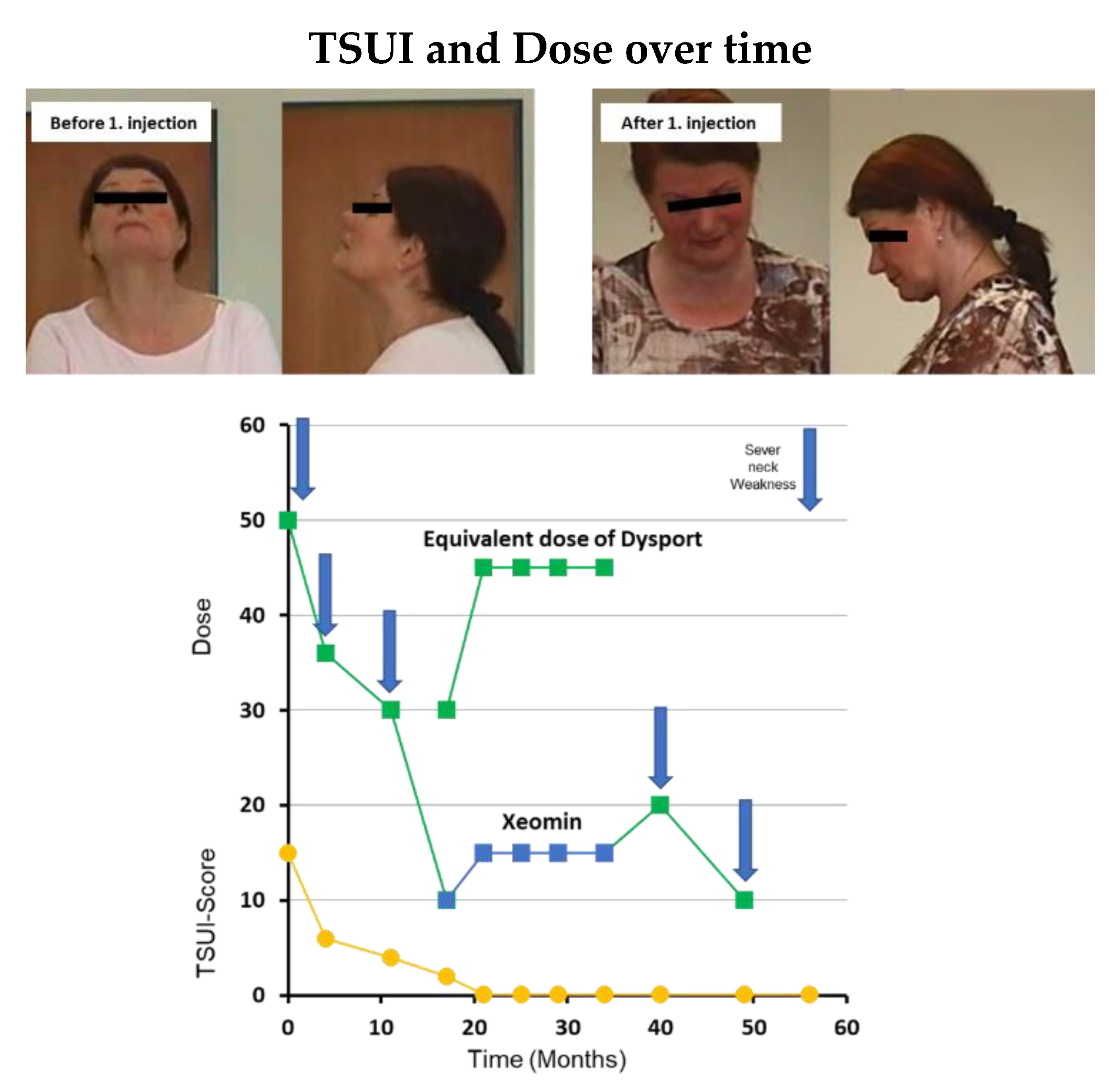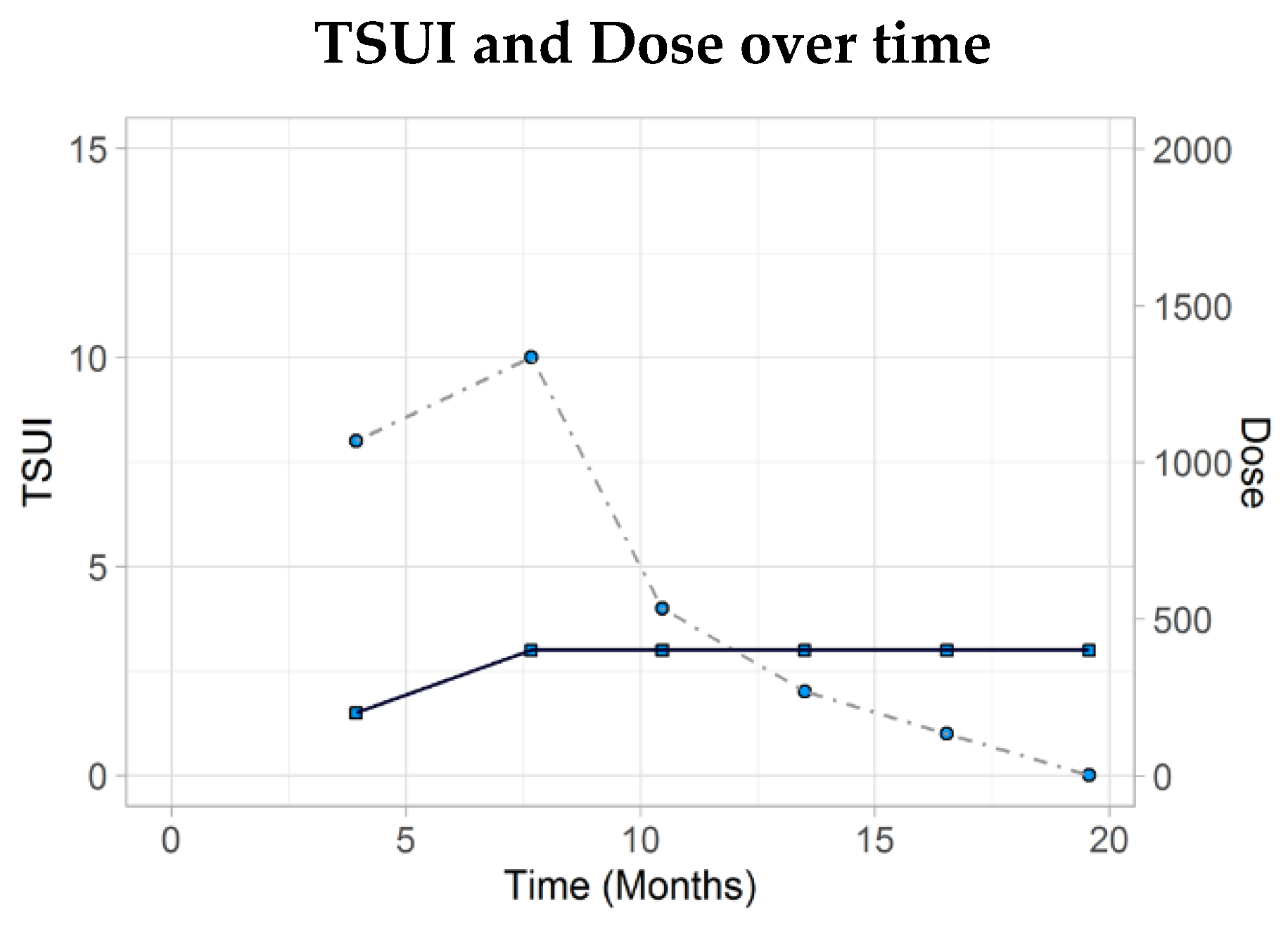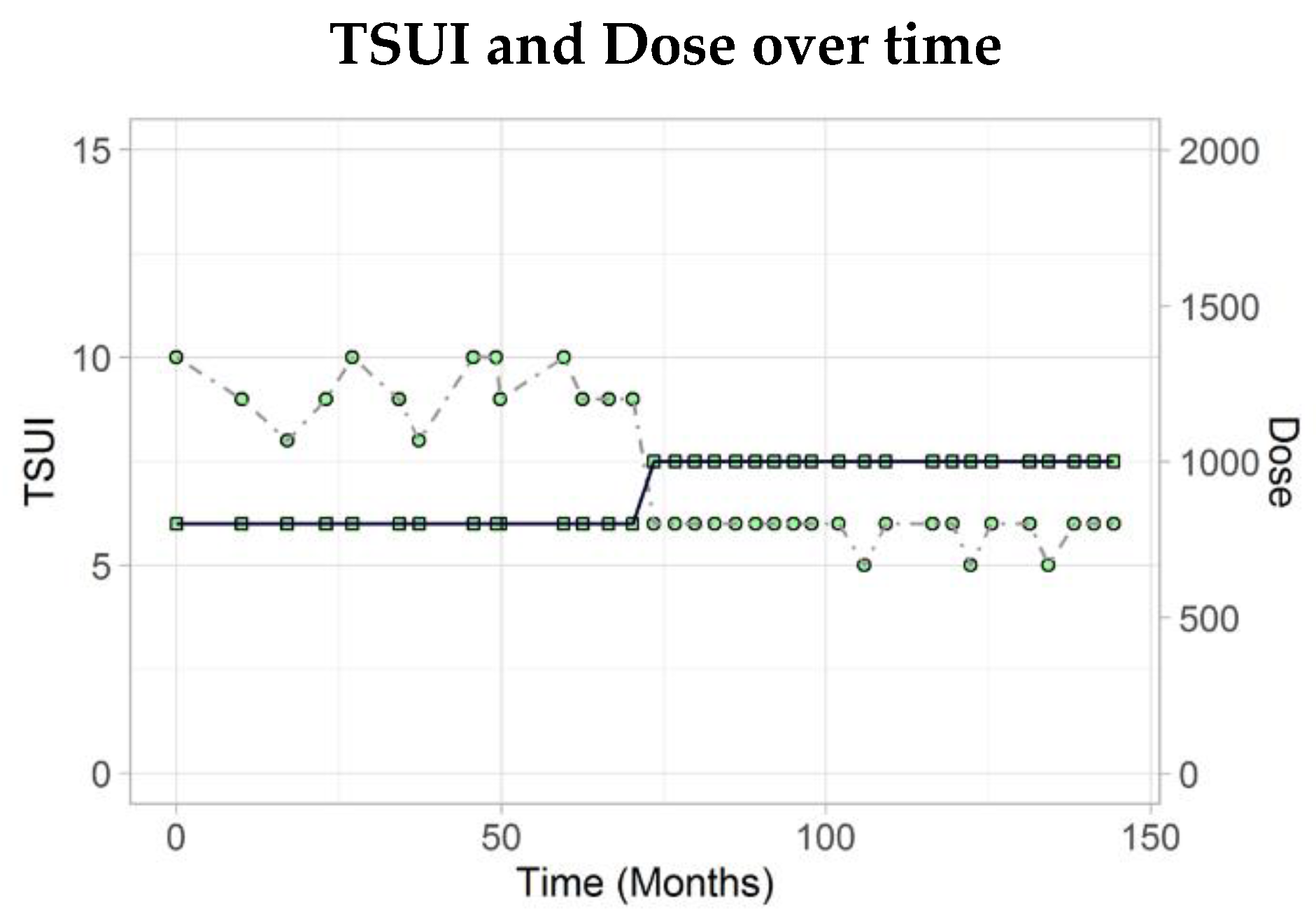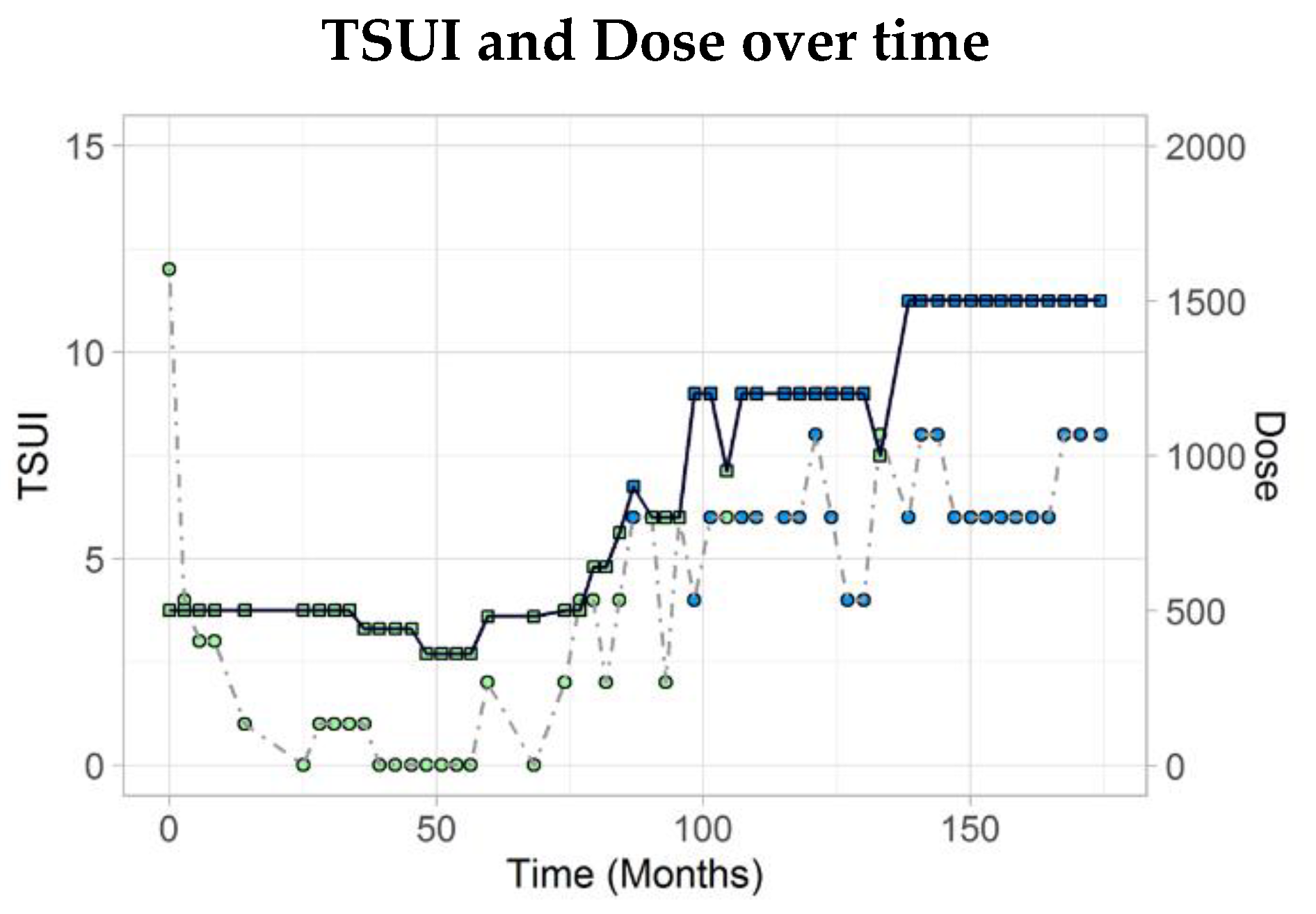The Extreme Ends of the Treatment Response Spectrum to Botulinum Toxin in Cervical Dystonia
Abstract
1. Introduction
2. Patients: The Concept of Treatment Response Variability to BoNT over Time
- The typical supersensitive patient;
- The insensitive patient to a standard dose being highly sensitive to a much higher dose;
- The typical insensitive patient;
- The patient with complete STF being highly sensitive after switch to incoBoNT/A;
- The initially highly sensitive patient with CSTF without response to incoBoNT/A.
2.1. Response at Onset (General Considerations)
The Typical Supersensitive Patient
2.2. Response during Dose Adjustment (General Considerations)
2.2.1. The Insensitive Patient to a Standard Dose Being Highly Sensitive to a Much Higher Dose
2.2.2. The Typical Insensitive Patient
2.3. Response after Development of Neutralizing Antibodies or Secondary Treatment Failure (General Considerations)
2.3.1. The Patient with Complete STF Being Highly Sensitive after Switch to incoBoNT/A
2.3.2. The Initially Highly Sensitive Patient with CSTF without Response to incoBoNT/A
3. Discussion
3.1. Insensitive and Supersensitive Patients at the Onset of Therapy
3.2. Supersensitive and Insensitive Patients during the Phase of Dose Adjustment
3.3. Sensitive and Insensitive Patients to Switch of the BoNT/A Preparation after Induction of NABs or STF
3.4. Future Investigations on Insensitive and Supersensitive Patients
4. Conclusions
Author Contributions
Funding
Institutional Review Board Statement
Informed Consent Statement
Data Availability Statement
Conflicts of Interest
References
- Caleo, M.; Restani, L. Exploiting Botulinum Neurotoxins for the Study of Brain Physiology and Pathology. Toxins 2018, 10, 175. [Google Scholar] [CrossRef] [PubMed]
- Sesardic, D.; Jones, R.G.; Leung, T.; Alsop, T.; Tierney, R. Detection of antibodies against botulinum toxins. Mov. Disord. Soc. 2004, 19 (Suppl. 8), S85–S91. [Google Scholar] [CrossRef] [PubMed]
- Tian, X.; Gao, L.; Fu, G.; Zhang, C.; He, Q.; Wei, N.; Huang, T.; Li, L. A rare case of severe systemic life-threatening botulism caused by a local botulinum toxin—A injection. JAAD Case Rep. 2020, 6, 854–857. [Google Scholar] [CrossRef]
- Arnon, S.S.; Schechter, R.; Inglesby, T.V. Botulinum toxin as a biological weapon: Medical and public health management. JAMA 2001, 285, 1059–1070. [Google Scholar] [CrossRef]
- Rossetto, O.; Montecucco, C. Tables of Toxicity of Botulinum and Tetanus Neurotoxins. Toxins 2019, 11, 686. [Google Scholar] [CrossRef]
- Torii, Y.; Goto, Y.; Nakahira, S.; Kozaki, S.; Kaji, R.; Ginnaga, A. Comparison of Systemic Toxicity between Botulinum Toxin Subtypes A1 and A2 in Mice and Rats. Basic Clin. Pharmacol. Toxicol. 2015, 116, 524–528. [Google Scholar] [CrossRef]
- Frevert, J. Pharmaceutical, biological, and clinical properties of botulinum neurotoxin type A products. Drugs R D 2015, 15, 1–9. [Google Scholar] [CrossRef]
- Hefter, H.; Spiess, C.; Rosenthal, D. Very early reduction in efficacy of botulinum toxin therapy for cervical dystonia in patients with subsequent secondary treatment failure: A retrospective analysis. J. Neural Transm. 2014, 121, 513–519. [Google Scholar] [CrossRef]
- Hefter, H.; Samadzazeh, S.; Rosenthal, D. The impact of the initial severity on later outcome: Retrospective analysis of a large cohort of botulinum toxin naïve patients with idiopathic cervical dystonia. J. Neurol. 2020. [Google Scholar] [CrossRef]
- Aoki, K.R.; Guyer, B. Botulinum toxin type A and other botulinum toxin serotypes: A comparative review of biochemical and pharmacological actions. Eur. J. Neurol. 2001, 8 (Suppl. 5), 21–29. [Google Scholar] [CrossRef]
- Hefter, H.; Brauns, R.; Ürer, B.; Rosenthal, D.; Albrecht, P. Effective long-term treatment with incobotulinumtoxin (Xeomin®) without neutralizing antibody induction: A monocentric, cross-sectional study. J. Neurol. 2020. [Google Scholar] [CrossRef] [PubMed]
- Bellows, S.; Jankovic, J. Immunogenicity Associated with Botulinum Toxin Treatment. Toxins 2019, 11, 491. [Google Scholar] [CrossRef] [PubMed]
- Hefter, H.; Kahlen, U.; Menge, T.R.; Rosenthal, D.; Moll, M. Impact of posterior deep neck muscles treatment on cervical dystonia: Necessity to differentiate between abnormal positions of head and neck. Basal Ganglia 2012, 2, 103–107. [Google Scholar] [CrossRef]
- Dressler, D. Clinical presentation and management of antibody-induced failure of botulinum toxin therapy. Mov. Disord. 2004, 19 (Suppl. 8), S92–S100. [Google Scholar] [CrossRef]
- Hefter, H.; Blondin, D.; Kahlen, U.; Moll, M.; Antoch, G.; Schek, J. CT-guided intramuscular botulinum toxin A injections into the deep anterior neck muscles in patients with pure antecaput or antecollis. Basal Ganglia 2012, 2, 97–101. [Google Scholar] [CrossRef]
- Dressler, D. Subclinical myasthenia gravis causing increased sensitivity to botulinum toxin therapy. J. Neural Transm. 2010, 117, 1293–1294. [Google Scholar] [CrossRef]
- Hefter, H.; Schomaecker, I.; Schomaecker, M.; Samadzadeh, S. Disease progression of idiopathic cervical dystonia in spite of improvement after botulinum toxin therapy. Front. Neurol. 2020, 11, 1533. [Google Scholar] [CrossRef]
- Jahanshahi, M.; Marion, M.H.; Marsden, C.D. Natural history of adult-onset idiopathic torticollis. Arch. Neurol. 1990, 47, 548–552. [Google Scholar] [CrossRef]
- Hefter, H.; Rosenthal, D.; Bigalke, H.; Moll, M. Clinical relevance of neutralizing antibodies in botulinum toxin long-term treated still-responding patients with cervical dystonia. Ther. Adv. Neurol. Disord. 2019, 12, 1–8. [Google Scholar] [CrossRef]
- Hefter, H.; Rosenthal, D.; Moll, M. High botulinum toxin-neutralizing antibody prevalence under long-term cervical dystonia treatment. Mov. Disord. Clin. Pract. 2016, 3, 500–506. [Google Scholar] [CrossRef]
- Albrecht, P.; Jansen, A.; Lee, J.I.; Moll, M.; Ringelstein, M.; Rosenthal, D.; Bigalke, H.; Aktas, O.; Hartung, H.P.; Hefter, H. High prevalence of neutralizing antibodies after long-term botulinum neurotoxin therapy. Neurology 2019, 92, e48–e54. [Google Scholar] [CrossRef] [PubMed]
- Dressler, D.; Hallett, M. Immunological aspects of Botox®, Dysport® and Myobloc™/NeuroBloc®. Eur. J. Neurol. 2006, 11 (Suppl. 1), 11–15. [Google Scholar] [CrossRef] [PubMed]
- Bigalke, H.; Rummel, A. Botulinum neurotoxins: Qualitative and quantitative analysis using the mouse phrenic nerve hemidiaphragm assay (MPN). Toxins 2015, 7, 4895–4905. [Google Scholar] [CrossRef] [PubMed]
- Lange, O.; Bigalke, H.; Dengler, R.; Wegner, F.; deGroot, M.; Wohlfarth, K. Neutralizing antibodies and secondary therapy failure after treatment with botulinum toxin type A: Much ado about nothing? Clin. Neuropharmacol. 2009, 32, 213–218. [Google Scholar] [CrossRef] [PubMed]
- Samadzadeh, S.; Ürer, B.; Brauns, R.; Rosenthal, D.; Lee, J.-I.; Albrecht, P.; Hefter, H. Clinical Implications of Difference in Antigenicity of Different Botulinum Neurotoxin Type A Preparations: Clinical Take-Home Messages from Our Research Pool and Literature. Toxins 2020, 12, 499. [Google Scholar] [CrossRef] [PubMed]
- Walter, U.; Mühlenhoff, C.; Benecke, R.; Dressler, D.; Mix, E.; Alt, J.; Wittstock, M.; Dudesek, A.; Storch, A.; Kamm, C. Frequency and risk factors of antibody-induced secondary failure of botulinum neurotoxin therapy. Neurology 2020, 94, e2109–e2120. [Google Scholar] [CrossRef]
- Dressler, D.; Bigalke, H.; Benecke, R. Botulinum toxin type B in antibody-induced botulinum toxin type A therapy failure. J. Neurol. 2003, 250, 967–969. [Google Scholar] [CrossRef]
- Hefter, H.; Samadzadeh, S.; Moll, M. Transient improvement after switch to low doses of rimabotulinumtoxinB in patients resistant to abobotulinumtoxinA. Toxins 2020, 12, 677. [Google Scholar] [CrossRef]
- Dressler, D.; Saberi, F.A. Antibody induced failure of botulinumtoxin therapy: Restart with incobotulinumtoxinA offers a new opportunity. Toxincon 2016, 123, S22–S23. [Google Scholar] [CrossRef]
- Hefter, H.; Hartmann, C.; Kahlen, U.; Moll, M.; Bigalke, H. Prospective analysis of neutralizing antibody titres in secondary non-responders under continuous treatment with a botulinum toxin type a preparation free of complexing proteins—A single cohort 4-year follow-up study. BMJ Open 2012, 2, e000646. [Google Scholar] [CrossRef]
- Oshima, M.; Deitiker, P.; Jankovic, J.; Atassi, M.Z. The Regions on the Light Chain of Botulinum Neurotoxin Type A Recognized by T Cells from Toxin-Treated Cervical Dystonia Patients. The Complete Human T-Cell Recognition Map of the Toxin Molecule. Immunol. Investig. 2018, 47, 18–39. [Google Scholar] [CrossRef] [PubMed]






| Mouse | Rat | Rabbit | Monkey | Human | ||
|---|---|---|---|---|---|---|
| Tetanus Toxin (ng/kg) | 0.5 ng/kg (IM) | resistant | 3 ng/kg (IM) | 0.4 ng/kg (IM) | 0.2 ng/kg (IM) | |
| Botulinum Toxin (* expressed as multiple of the mouse LD50/kg) | BoNT/A | 1 (IP) * 1 (IM) * | 2.5 (IP) * | 0.3 (IP) * 0.8 (IM) * | 0.78(IM)* | 1.3–2.1 ng/kg (IM, IV) 10–13 ng/kg (INH) 1000 ng/kg (oral route) |
| BoNT/B | 1 (IP) * 1 (IM) * 1 (INH) * | 1000 (IP) * | 0.1 (IM) * | 150-432(INH)* | ||
Publisher’s Note: MDPI stays neutral with regard to jurisdictional claims in published maps and institutional affiliations. |
© 2020 by the authors. Licensee MDPI, Basel, Switzerland. This article is an open access article distributed under the terms and conditions of the Creative Commons Attribution (CC BY) license (http://creativecommons.org/licenses/by/4.0/).
Share and Cite
Samadzadeh, S.; Brauns, R.; Hefter, H. The Extreme Ends of the Treatment Response Spectrum to Botulinum Toxin in Cervical Dystonia. Toxins 2021, 13, 22. https://doi.org/10.3390/toxins13010022
Samadzadeh S, Brauns R, Hefter H. The Extreme Ends of the Treatment Response Spectrum to Botulinum Toxin in Cervical Dystonia. Toxins. 2021; 13(1):22. https://doi.org/10.3390/toxins13010022
Chicago/Turabian StyleSamadzadeh, Sara, Raphaela Brauns, and Harald Hefter. 2021. "The Extreme Ends of the Treatment Response Spectrum to Botulinum Toxin in Cervical Dystonia" Toxins 13, no. 1: 22. https://doi.org/10.3390/toxins13010022
APA StyleSamadzadeh, S., Brauns, R., & Hefter, H. (2021). The Extreme Ends of the Treatment Response Spectrum to Botulinum Toxin in Cervical Dystonia. Toxins, 13(1), 22. https://doi.org/10.3390/toxins13010022





